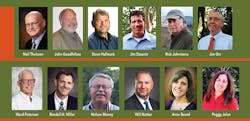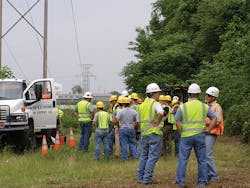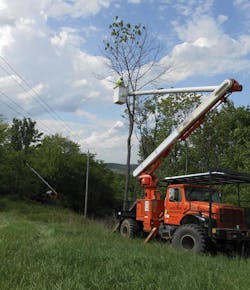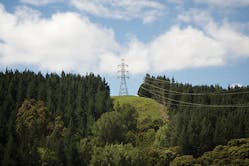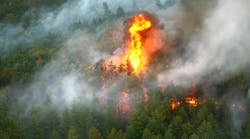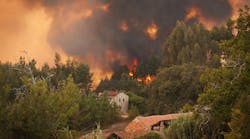Transmission & Distribution World editors interviewed a dozen past presidents of the Utility Arborist Association, asking each to comment on key issues in vegetation management during their presidential term as well as challenges the association faced at the time. We also asked them to comment on important issues the vegetation management industry and the UAA face today.
1991 Neil Theissen
During my time as UAA president, and certainly in western Canada, utilities were starting to look at longer-term vegetation management programs. The utility I was with at the time, TransAlta Utilities, had agreed to look at a 12-year program to make its rights-of-way sustainable, which was pretty unique back then. Everybody had programs, but this one had six years of catch-up funding and six years of future funding included in it. This is really when the utility transitioned its vegetation management efforts from a hot-spot program to a fully funded, systematic, integrated vegetation management (IVM) program, which was also pretty unique at the time.
As far as the UAA goes, those were interesting times. During my tenure as vice president and then president, there was a transition from what I would call the “good old boys’ club.” There were not many Canadians involved, and I was the fresh new upstart. I got involved in committees, and pretty soon people were saying they wanted me to run for president in a couple of years. We had an election, and it was like nobody dared to put another nomination on the floor. I was astonished.
At that time, there had never been a non-utility employee voted in to serve as vice president, but, during my tenure, we finally got enough members to open up the doors on the nomination committee. We opened up the leadership to non-utility members and we got contractors and consultants involved.
It was never the same after that, and I say that in a good way. I was told we couldn’t sell advertising in the UAA newsletter, but we created a newsletter where we had sponsors. The chemical companies started to get involved, and it was no longer that tight little club. It was harder to blame everything on contractors when they were sitting on the board.
The whole industry has matured. While they did a lot of good work back in the good old boys’ days, change has been good for the UAA and the industry.
What I see, honestly, in the work I do is that the industry has definitely matured, but we are still reinventing the wheel a little bit too much. People get so incestuously internalized they cannot see outside their own utility. Some utilities believe they have the best program in the world, and they do not look outside for new ideas. The working relationships between utilities and contractors could be improved. There is still a little too much of not working with each other well enough, so we don’t always understand each other’s goals.
There also is some lack of support from the utilities, in particular, to send their people to conferences and have them involved in the work of the UAA. Some utilities are restricting travel so much that their employees can’t travel outside their area. I learned a ton from hundreds and hundreds of people by being involved in committees and with other utilities at conferences and meetings around the world. That is something some utilities are very shortsighted on now, by not insisting more of their people stay involved.
1992 John Goodfellow
Two really significant things happened during my tenure. First, the UAA had gotten large and complicated enough that we could afford an executive director. We recruited Derek Vannice and went from being all volunteer to having someone on staff to do more than we could do before and provide a better level of service. He was basically sitting there in the International Society of Arboriculture (ISA) offices in Champaign-Urbana, Illinois, so it strengthened our connection there, too.
The second significant item was the beginning of the debate on certification for arborists. Did we even need certification? Was it valid, did it create value, and what would be done and why? It took a number of years for it to get going. A key discussion point was whether it was necessary to have a credential to be an arborist first and then, beyond that, to be a utility specialist.
Today, the biggest issues have to do with demonstrating the value of vegetation management. It’s about cost justification, but it’s more than that. It has always been the same thing: the utility vegetation management (UVM) guys don’t always know how to talk to the financial guys at the utilities, essentially how to rationalize the cost and returns to good vegetation management. We continue to have to demonstrate the value of what we do and why we do it.
Another issue is how to continue to engage people in the organization. I was 35 when I was president, and as I look at the UAA now, there appear to be a lot of long-in-the-tooth veterans. I think we need to get the farm system going again.
1995 Steve Hallmark
Before I was president, the UAA was moving toward developing the utility arborist credential. We moved to strengthen our affiliation with the ISA, and there was a movement started to consider how we work to improve the professionalism of the utility arborist industry.
This was something of a divisive issue, with pushback especially from contractors. The pushback was the idea that all this would be is a card you stick in your wallet, which would not justify the additional cost for all these people to become certified.
Then the question became, what does it mean to be an arborist? It should not be just paying $20, at that time, to join the organization. There was real division within the industry whether this was needed. I remember a phone call from a large tree company in North America saying it had concerns and certification was a mistake. The company said the cost would be passed along to their customers and nobody would gain from it.
It took a while to get there, but we agreed to move forward. We aligned ourselves with the ISA program. The UAA became a bolt-on to it, and it has now become the model for other professional associations that belong to the ISA. We were really groundbreakers, establishing the system by which the municipal arborists, commercial arborists and others work today.
While certification is still voluntary today, many utilities now encourage it or require it of their employees. Some also require contract personnel to be certified.
The other issue of the day was the UAA awards. I brought it to the executive committee and sponsored it. There were a lot of individuals who had contributed significantly to the industry who deserved to be recognized. We are now at more than 20 years with the UAA Award, the Education Award and the Lifetime Achievement Award. We have an annual meeting every August, and the awards are presented at that time. Winners are nominated and selected by a committee of their peers. These awards recognize those who have contributed tremendously to the field.
Today, the big issue for me, personally, is I am coming to the twilight of my career. I have just a few years left before I move on, so I think about how we are preparing the next generation to be the best they can be within the industry. I’m not talking just about the utilities but the contractors, too. How are we doing at that now? We really have to focus on bringing that next generation along into the industry.
We have a good pool to pull from, though. Colleges are producing a lot of people in the natural resources field to fill these roles. We need to help them to understand what it takes to become a good vegetation manager. We have to make sure we are offering the right educational materials to help them learn best practices.
1997 Jim Downie
Back when I was UAA president, I was a much younger man and the memory of working on a line clearance tree crew was still fresh in my mind. So my focus as president was to try and highlight issues related to worker turnover and the negative impact turnover was having on our industry.
We needed to — and still need to — understand the impacts of tree worker turnover in terms of productivity, quality of work, customer relations and, most importantly, worker safety. Back in those days, there was a lot of passion and frustration from the tree contractors as they struggled to meet the needs of the utilities. At issue was trying to meet the performance expectations of the utility while struggling to establish crews and keep them engaged while experiencing foreman turnover rates greater than 50% and entry-level-position turnover at almost 200%. Many utilities in those days — and still to some degree today — seem to think worker turnover is solely the contractor’s problem.
As part of a strategic sourcing initiative in 1996, we partnered with our tree contractors to attempt to solve the turnover problem. In short, after doing some research and analysis, we convinced our executive leadership that investing in the contractor workforce (through wages, benefits and recognition) should pay big dividends in terms of improved productivity, customer relations and quality of work.
In the end, those investments provided dividends that far exceeded the investment, as it resulted in higher-quality work being completed with fewer crews. What we didn’t anticipate was the remarkable improvement in worker safety from these investments. We watched our lost-time incidents per 100 workers drop from 18 to less than one per year in just four years.
As an industry, we need to universally adopt a mindset that line clearance tree work is not just a job but a career. Where we have seen utilities partner with contractors to strategically invest in the workforce, we have seen significant improvements in safety, productivity, quality of work and customer relations. This is possible in both non-bargaining and bargaining work environments.
Success requires a utility/contractor relationship based on trust, integrity, transparency and a willingness to take some calculated risks, all of which are hallmarks of many successful UVM programs in North America.
1999 Rick Johnstone
The key issues I worked on as head of the UAA were how to put the educational program together as well as how to get dialogue between the utilities and federal land management agencies. We invited the U.S. Environmental Protection Agency (EPA), U.S. Forest Service and U.S. Fish & Wildlife Service to give their ideas on vegetation management on lands for which they were responsible. I was a system forester on the Delmarva Peninsula at the time, and so I was used to working within a partnership approach for all the sensitive issues in that Chesapeake Bay habitat, things like selective herbicide use and managing vegetation rather than just mowing. We were helping wildlife in the area by increasing wildlife habitat and sediment control.
Both sides of this issue work well for the public. Government agencies have been charged to manage the land and we have been charged to deliver electricity. At that time, though, the only time we would talk to each other was when the utility did something wrong or it was seeking a permit.
A key issue today would be continuing to focus on controlling invasive plants and bringing back native prairie types of plants, grasses and wildflowers, thus providing good or better habitat. We need to get everyone practicing good IVM.
We also need to be the antagonist against those who do not believe in IVM. The approach some utilities are taking to meet Federal Energy Regulatory Commission (FERC) outage regulations is just to mow everything. That is not management, but some of the utilities are pushing to do this, and sometimes the foresters are mute, not saying anything. A lot of the foresters are afraid to stick their neck out on this issue or it might get chopped off.
Hopefully, soon enough, the agencies will look at this and wonder why they are simply doing routine mowing. The research on this is more than 63 years old. The science is old. When you are looking at long-term reliability, it is an endless process just to perpetuate trees you should be removing. Utilities could be removing trees instead, taking out the species that are a problem. Then, every time you come back in, you have less to do because you have natural competition, biological controls. You are working with nature rather than working against it.
2007 Jim Orr
For me, a big issue of the time was community and customer involvement. In 2006 and 2007, we were reeling from the big Northeast blackout of 2003, which was still very fresh in everybody’s minds. Some of the final reports were put in place, and the regulations were starting to be implemented and talked about. That was a very interesting time in terms of transmission vegetation management. That is when they started talking about FERC-003. It was an active time regarding the regulation of transmission line vegetation management.
The new regulations required more aggressive vegetation management. Utilities had to meet stricter guidelines. Many utilities had to create vegetation management plans, some for the first time. Then they had to work to those plans, and they had to increase vegetation budgets significantly. Up until that time, it had been very much self-regulated. There was a blackout in 1967, one in the 1980s and another in 1997. The first one back in the 1960s precipitated the regional reliability council. But the blackout that really got the government involved was 2003, of course.
Regarding the 2003 blackout, from a vegetation management standpoint, in particular, the lines that went out from the tree branches in Ohio, which were blamed for the initial fault, simply should have been isolated. But there were multiple lines out for repair or maintenance at the time it happened. There wasn’t enough redundancy or cushion in the system to handle the initial fault — the Ohio trees — and so the dominoes began to fall. It was the power line engineers, in this case, who lined up those dominoes.
Trees and power lines don’t mix, and they never will. The conflict is going to be ongoing as long as there is an overhead grid. Somebody may say that in 20 years power will be distributed at the household level and everyone will be running a turbine or a fuel cell, but there will likely still be a grid in place, at least as backup.
One of the key issues today is the emergence of the emerald ash borer. Hundreds of millions of trees are going to die and untold millions are going to be near power lines, and they are going to fall down. You have a 50-50 chance of having a problem. The numbers are staggering. It’s already bad in the Michigan, Ohio and Indiana areas, and it’s spreading to the northeastern U.S. The stakes are in the many millions of dollars for each utility — an enormous cost — and that is just the financial cost of cutting down trees. The other issue is the problem of losing significant street tree cover. Many communities planted thousands of ash trees when Dutch elm disease took out all the elm trees. Now the emerald ash borer is coming after those very ash trees.
2008 Ward Peterson
The UAA was doing great at the time I was president. We had been growing well and had good leadership and a really strong team. It was very much a can-do team. Whenever there was something to be done, someone always seemed to step up and say, “I’ll take care of it.” It was really nice to be working with a team and organization like that.
One of the things we wanted to do was get more discussion going between utility foresters and system foresters. We wanted internal experts talking to each other, building on the strength that was already there.
The transmission reliability issue got solved at that time, in my opinion, with a two-by-four. FERC basically said, “You are going to do it [secure transmission reliability], or you are going to pay a lot of money, and we are going to write nasty letters to your CEO.”
Today, we are getting harder hit by storms. There seem to be more major storms, and so storm hardening needs more attention. We are doing a pretty good job of line clearance, but reliability is being affected negatively from trees outside the rights-of-way. I would like us to understand more about trees and tree failures, and see a more systematic approach to the questions of storms and reliability.
I chaired the UAA research committee before becoming president and am co-chairing it again today. We are very actively looking at pollinators and rights-of-way, biomechanics and proactive maintenance.
2009 Randy Miller
One of the key issues during my time at the head of the UAA was best practices. We had just come out with IVM best practices, and I think they were widely accepted, but communicating them out to people was the key challenge. We started a series of summits on safety, too; that was another key goal and hot topic at the time.
One of the key advances today is in the use of technology. I see a lot of things coming out with automation and computers to help us out in the field as well as to help a manager at their desk understand what is going on in the field.
With the UAA, research is a big thing right now, including the TREE Fund board. We can now fund our own research projects and cooperate with the utilities to fund meaningful research.
Interesting research today includes John Goodfellow’s work on quantifying budgets. This gives utility arborists data they can send up to management. We are seeing more objective data, getting better hazard tree information and understanding better how trees cause outages. We are following up on the Gamelands 33 project in Pennsylvania. We need to duplicate it in the West and in other areas of the country so it has greater applicability and acceptance.
The ROW Stewardship program also is very important. Utilities can now be credentialed for performing right-of-way management in an environmentally responsible manner. We will gain credibility there, too, and that will tie into our research. We need to show and prove we are both environmentally sound and providing reliable electricity.
2010 Nelsen Money
During my time, the pressing issues were the new FERC regulations and how the utilities were attempting to implement them. A lot of utilities decided to clear from A to Z and take something of a Sherman’s March to the Sea attitude. That ended up in a lot of bloody noses and black eyes to the utilities’ images. There was this feeling the North American Reliability Corporation (NERC) had said there would be no outages, and so utilities were trying to do it in one cycle, and they did not feel there was any room for negotiations. The utilities found there was some really stiff opposition to wholesale clearing and many had to back off. They found they were able to take enough trees down to ensure reliability without having to clear-cut everything.
One of the other big issues was so many of the people on that [FERC regulations] committee were engineers, and they would not accept the opinions of the arborists about requiring professional qualifications for vegetation managers. They pretty much thought anybody could manage these vegetation programs.
Utilities also had a great deal of latitude as to what they would put down as clearance requirements. Many were demanding greater clearances than they needed at the time, just to go in and grab the maximum clearance they thought they needed once and not have to deal with it again.
The other issue was difficulty in dealing with federal agencies such as the U.S. Forest Service or the Bureau of Land Management. They often did not support the utilities’ need to manage their corridors. Do we need to use herbicides, they would ask? There was not much understanding or support at the forest service level, even though at the congressional levels and NERC there was support for us doing that work. NERC was telling the utilities they needed to do this or there were going to be fines and litigation costs.
The utilities thought we have to have absolutely zero risk, but they overshot there, too. They could have gotten to that with a third or half of what they took out. There were trees that were 50 years old, and the utility would come through and say even if it’s your favorite tree, too bad, it has to go. There were a lot of stories in cities and communities about this controversy, about clearing.
Going forward, one of the big issues for the UAA and the industry is the ROW Stewardship Accreditation program, which is needed but being resisted by some vegetation managers in our industry. Some vegetation managers think they are going to lose more control of their programs to others within their own utilities as well as to environmental and media folks.
These utilities are plowing forward and removing everything they can, and they really should step back and talk more to external and internal partners. They could use that ROW as an asset for the utility’s image. They should be looking at partnerships with native plant societies and pollinator partnerships. These would result in more positive images but require more planning on their part. Some of this is being resisted by the vegetation management within the utilities, because it requires a lot of community notification and stakeholder involvement.
2011 Will Nutter
The biggest obstacle I experienced during my term as UAA president in 2011 was losing our executive director, Derek Vannice, who went back to work in the private sector. About 25% of Derek’s time was devoted to the UAA and 75% to the ISA.
After Derek left, we decided the UAA needed at least a part-time director, so we put together a panel and began interviewing for the position. This position is instrumental to the UAA. We knew that we needed to find another dedicated person to fill the seat so we could continue being successful. We hired Phil Charlton for the role as executive director. He began as our “part-time” director, intending to work an average of 20 hours per week, but I think he ended up working about 40.
We also added some support staff at the ISA; this was the UAA taking a stance that we were there to stay. We raised our membership dues slightly, worked on various committee initiatives and set up regional meetings to help fund a full-time administrative employee, Jessica Carroll.
Having the right staff in the right seat was crucial to building a strong and successful organization. However, there was — and still is — the lingering issue of labor in our industry. The challenge as a contractor is pricing and continuing to compete in the market. We are competing for quality general labor and that struggle does not just affect our industry. There’s no getting around the fact that it’s a struggle to find, compensate and keep good labor.
Up to this point [2011], the UAA hadn’t really done more than dipped its toe into the issue of worker safety. The utilities, in particular, had always tried to keep contractor safety at arm’s length. Their attitude was that they didn’t want the responsibility on them and their mindset was “you’re the contractor, so please be safe.” In result, the UAA created a safety committee. We attracted new members and new volunteers.
Fast-forward to a few years later, and the safety committee has members from every major contractor in the U.S., as well utility participation and an International Brotherhood of Electrical Workers (IBEW) member. We like to take a strong approach by tearing down walls when it comes to safety. After all, we all have common safety goals — it’s not like pricing where we have to compete with each other.
The UAA holds safety summits throughout the U.S., focusing on the field-worker level. We leave our titles at the door and really get to the heart of the issues surrounding safety in our industry. We are constantly asking ourselves, “What are best practices and how do we communicate them to our field employees?” We are trying to break down the barriers in communication between utilities and contractors to make sure we’re doing everything we can to keep our employees safe each and every day.
2013 Anne Beard
There were several key topics of interest during my time as UAA president. One was that we formed a new safety subcommittee, and developed and held two highly successful safety summits. We have had several more since then. We are trying to focus on and highlight the importance of safety from the tree trimmer all the way up to the president of the company — for workers in the field as well as administration and managers.
The ROW Stewardship, an excellent tool for assessing IVM techniques and programs, was launched at this time. UAA was instrumental in helping to develop this program. It is run independently by a third-party partner, and five utilities have been accredited.
There has been a lot of work around the memorandum of understanding with federal agencies in Washington, which was originally signed in 2006. We made a couple of trips to Washington, and spent a lot of time revamping the language, making it more relevant to today’s environment. We also tried to give it a little more pertinence than the previous version. There are plans to make another trip back to Washington to speak with the House Committee on Natural Resources this year, and legislation is being developed to bring to vote before Congress regarding UVM activities on federal land.
The Utility Arborist Research Fund had its first fully funded project during this time. The business case was about the cost/benefits of performing UVM work on a preventive versus corrective basis, and how best to determine the optimum vegetation management cycle. It was bid out to John Goodfellow with BioCompliance Consulting. He has completed phase one, and phase two of this research is forthcoming. This was a big step for the UAA. Historically, there had been some research funded through the TREE Fund, but there was a lack of funding in the UVM area. It’s been nice to have the UAA start to fund research on its own.
2014 Peggy Jelen
Our big issue that should be the focus in our industry today is safety. We are incorporating emphasis on safety issues where and whenever we can with both utilities and contractors within the vegetation management world. We’ve seen a lot of progress in several arenas. For example, bringing more frontline people to safety summits that are now being organized around the country. Sometimes only management attends conferences and workshops that address the safety concerns we all share, so we are incorporating more foremen and general foremen workers into these summits. We are definitely working toward the goal of enlisting UVM workers to take ownership of safe work practices on the job.
UAA has also made the safety committee its own committee; it was formerly a subset of the training committee, but it started getting so much attention that we split it out on its own. We’ve all seen what can happen if you don’t pay attention to the basics of worker safety and worker involvement, and what’s mind-boggling is how we, as an industry, still do not always to get it. Invest in your workers. Make this more of a career than a job — particularly for the frontline guys — and you will be so much better off.
Another focus is improving storm outage prevention and recovery, with an emphasis on the need for good communication between upper management, vegetation management folks and contractors. Communication is big when it comes to managing storms. You need to have a plan in place, work to the plan and follow up with inspections. When the storm is over, you need to inspect to make sure everything was completed correctly. In fact, one of the UAA/ISA conference panels focused specifically on Superstorm Sandy. We want to make sure everyone is looking at lessons learned from other utilities — what works and what doesn’t.

